An introduction to human grooming
On this page
Folds in the skin
Your skin is folded all over.
What people call lines and wrinkles are actually folds in the skin.
Your entire body is crisscrossed by folds from head to toes.
Some are plain to see, some need closer inspection to be seen, but many cannot be seen at all.
Humans are born with folds in their skin.
| Folds on a baby's wrist |
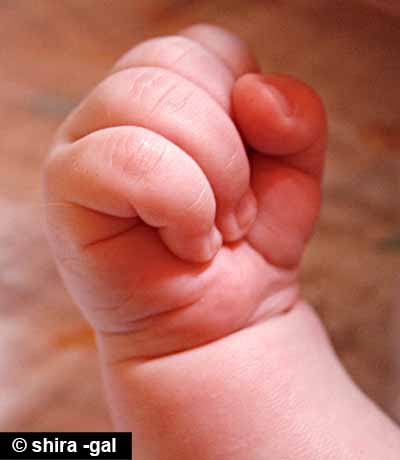 |
The folds on this baby's hand won't disappear with time; they'll only get deeper, more numerous and more tense.
When this baby gets older, these folds will limit the extension of each articulation.
Later, some pain will arise when some actions are performed.
Still later, any movement will be limited by the pain generated by the strangling folds.
Additionally, the folds have an adverse effect on your appearance.
Two ways to groom
Grooming your skin can help you unfold some folds and lessen the tension in some fold crossings.
There are two main grooming techniques:
• Pressure grooming
• Superficial grooming
Each method addresses a specific cutaneous problem, but most of the work is done using pressure grooming techniques.
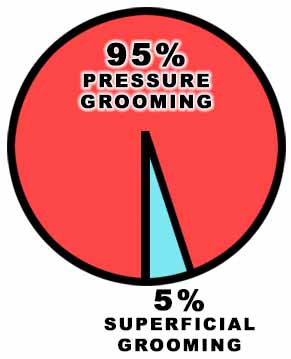
Pressure grooming
For a complete pressure grooming guide, click here.
Removing your folds with pressure grooming
Pressure strokes are used to unfold the folds in your skin by crushing them.
If you put some pressure on the folds with your nail or fingertip, you open them up and destroy their foundation.
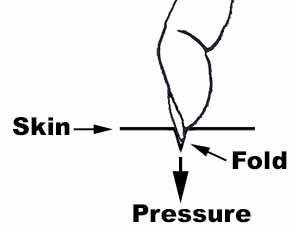
HOW TO PROCEED
Apply pressure on one spot for one to ten seconds or more, move away a bit and start over.
You want to open or crush any hardened structure you meet.
Exert all the force you can without hurting yourself.
This action may leave nail marks on your skin, but they should fade out in a few minutes.
If they don't, reduce the pressure you put on your finger.
Short and long pressure strokes
Most pressure strokes are short in duration; lasting less than five seconds.
Short pressure strokes are the most used grooming gesture.
With them, you can repeatedly crush and compress any skin defect or fold.
You can perform hundreds of short pressure strokes on a very small skin area.
You rely on the information that comes from your fingertip and from the skin location you are grooming to direct your efforts.
You only resort to long pressure strokes when you feel that your nail or fingertip is positioned on a fold crossing, a weak spot in the skin structure that you're trying to crush.
As soon as you realize that you've found such a spot; don't move!
Freeze your position, while maintaining the pressure.
Keep on pressing.
You will feel your nail penetrating your skin, while the cutaneous feature you are grooming gives in.
Only end your pressure stroke when no more unfolding occurs.
Why use your nails and fingertips?
Q: With today's technology, wouldn't there be a simpler and faster method?
A: Your nails and fingertips are the most adequate and advanced tools for this task; because they are sensitive.
You only want to pressure groom your skin where it is folded; not in between.
With your nails and fingertips, you can discriminate between folded and unfolded skin areas.
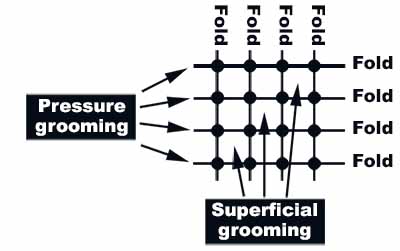
Your nail's blunt edges allow you to put enormous pressure on your skin in precise locations.
You only want to put pressure on folds and their crossings.
If you go wrong, you can hold back your nail's action as soon as you feel pain.
Superficial grooming
For a complete superficial grooming guide, click here.
Incomplete skin renewal
Your epidermis continuously renews itself from the bottom by producing new skin cells.
Older cells are pushed up the epidermis until they reach the top, where they die and flake off.
However, the process has its limits and dead cells pile up here and there, thickening your skin.
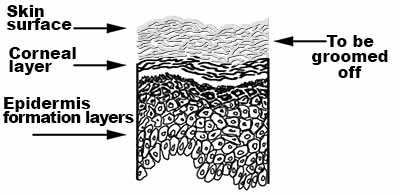
Grooming your skin superficially completes the desquamation process.
Stay away from abrasives such as: rasps, stones, exfoliating brushes or gloves, exfoliating cleansers and soaps, chemical exfoliants, ...
You will get much better results using your nails.
How to groom superficially
Align your fingers, excluding the thumb, so that your nails form a line.

HOW TO PROCEED
Gently rake your skin with your nails, using a back and forth motion, while applying a very delicate pressure mostly during the pulling phase.
Your nails should only pass a few times over the same section of skin.
Move along and cover your whole body.
In hard to reach places, you'll have to groom using one single finger.
Grooming basics
Where to groom?
Your entire body should be groomed daily.
However, your skin is supposed to tell you itself where it needs to be groomed.
Itches, irritations, twinges, cramps, aches and pains are all increasingly rude orders to groom specific places.
Ignoring such signals has put you in the state you're in.
You should also groom a region because it shows visible marks, spots, lesions, holes, bumps or because it has aesthetically deteriorated.
What finger should you use?
You can use any finger you wish.
The index finger on your writing hand is usually the most sensitive.
However, you will often find the need to use several fingers at once to cover large surfaces.
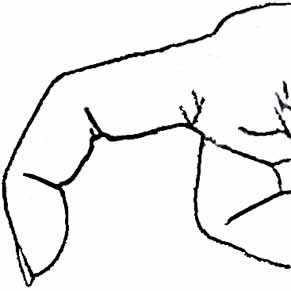 |
| Single-finger grooming |
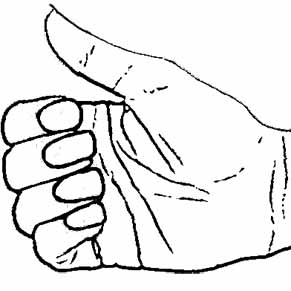 |
| Four-finger grooming |
I also recommend using both hands anytime you can.
The second hand can mimic the other, or it can help the grooming hand by stretching and stabilizing the skin.
Finger sensitivity
Each finger feels differently.
Your grooming finger should be your most responsive; your other fingers being less sensitive, in varying amounts.
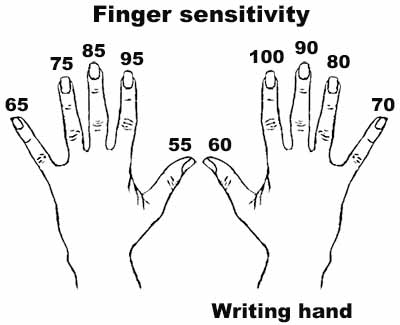
When you groom, try to vary your habits and alternate the fingers you use.
You generally want to work with your most sensitive digit, but for orientation, strength and fatigue reasons, you may get better results by using another one.
Finger strength
Some fingers are stronger than others.
Your thumb has the most power, followed by your middle finger.
Each person is different, but here is a simple chart.
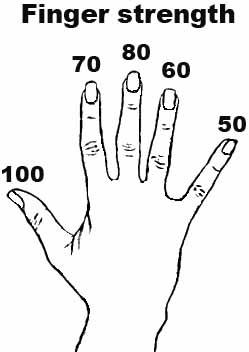
Your thumb may not be very agile, nor sensitive, but it is the strength champion.
When you need power to groom hardened locations, use your strongest fingers.
Grooming strokes
Four types of grooming strokes
Grooming is accomplished stroke by stroke.
A stroke is the gesture of pressing your finger onto your skin and grooming it for a moment.
You generally start over immediately.
Since there are two ways to groom, with superficial and pressure techniques, and each can be performed using one or four fingers; you get four different types of grooming strokes.
PRESSURE GROOMING
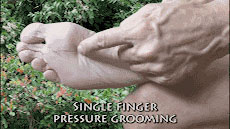 |
| Single-finger |
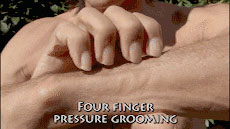 |
| Four-finger |
SUPERFICIAL GROOMING
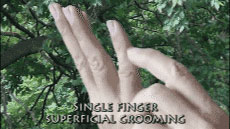 |
| Single-finger |
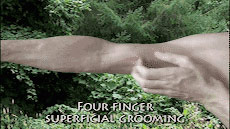 |
| Four-finger |
Each stroke is described in detail on these pages:
• Pressure grooming
• Superficial grooming
One stroke after another
Strokes are repetitious gestures.
They can be divided into three phases;
1• The finger strikes the skin,
2• The nail grooms the skin in some manner,
3• The finger is retracted.
Each grooming stroke usually lasts between one and ten seconds.
These movements have to be done over and over to get any result.
Support and grasp
Whatever part of your hand that is not used directly in the grooming action may act to support it.
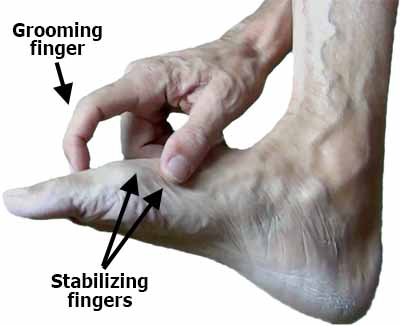
The unused fingers may stretch and stabilize the skin or simply anchor your hand for stableness.
In some positions, you can rest your whole hand on your skin, relieving you from the weight of your arm.
I also recommend that you engage your other hand to aid and support your grooming hand.
For more on this subject, see the two-handed grooming page.
Moving just the tip of your finger
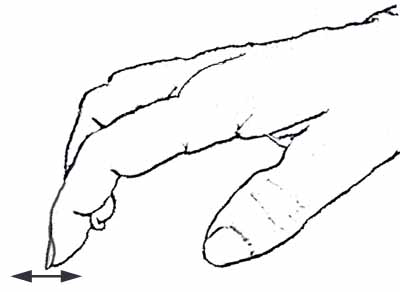
In many situations, the area you are grooming is very small; such as a fold crossing.
Your nail should peck it repeatedly for a while.
Once your hand is well positioned, all you have to move is the tip of your finger(s).
Nail and fingertip positions
Using the nail only
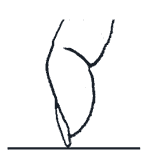
The nail then performs most of the sensory signal reception and all the grooming work alone.
Using both the nail
and the fingertip
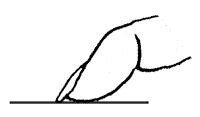
Even occasional fingertip contacts with the skin relay mounds of information. Any part of the flesh will do.
Using the fingertip only

It's amazing how much grooming you can do without using your nail.
Often, just pressing your fingertip on a folded area will flatten it, and open it up.
Warnings and recommendations
Don't hurt yourself
It's very easy to wound your skin while grooming.
Putting just a little too much pressure may result in a small lesion, abrasion or scratch.
Sometimes, you may even get to the point where the skin will bleed and not realize it until later.
Harming your skin won't help it.
Control the force you exert on your skin with great care, mostly when exploring new grooming techniques or when working on less familiar areas of your body.
Grooming, when performed correctly, should be a rejuvenating experience for your skin, with few after effects.
Precautions
Plan your work over a long period.
Each region of your skin will respond differently to your grooming.
If an area reacts badly to your treatment, stop grooming there until it heals.
Reversibility
Grooming has the amazing ability to restore your skin's healthy condition.
All the folds on your body can be unfolded.
Even the worst problems seem reversible.
|
|
Next page
|